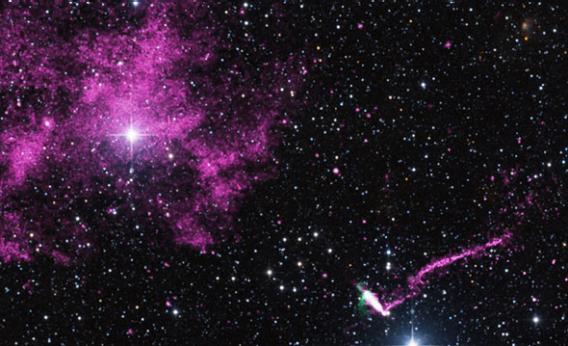Create a free profile to get unlimited access to exclusive videos, sweepstakes, and more!
A Corkscrew Unwinds From a Galactic Cannonball

Sometimes, when the Universe does something, it does it big.
The picture above shows the aftermath of a colossal event: 20,000 light years from Earth, a massive star exploded, showering the space around it with high-speed debris and flooding it with fierce light, which for a time outshone the entire galaxy. But it did more than that: The core of the exploded star collapsed into a ridiculously dense neutron star, which then shot away from the explosion like a multi-octillion ton cannonball.
Got that? Because it gets even weirder and awesomer. The intense energy emitted by the neutron star is blasting out a wind that trails behind it like a comet tail and also focused twin jets of matter blasting away from the poles of the star like a corkscrew hundreds of trillions of kilometers long.
So yeah, I love this image.
The picture itself is a combination of observations from three different telescopes in three very different flavors of light. X-rays from the orbiting Chandra observatory are colored purple; radio waves seen by the Australia Compact Telescope Array are in green, and infrared light from the 2MASS survey is shown in “natural” (that is, red, green, and blue) colors. I’ve written about this object before, but what’s new here is the detail; this is seen in X-rays better than ever before.
X-rays are generated by very high-energy and typically violent events. The cloud in the upper left qualifies: It’s the expanding debris from the supernova, which we see something like 10,000–20,000 years after the event. Shock waves inside that material can heat it to fierce temperatures, causing it to glow in X-rays.
We see that a lot in supernovae remnants. What’s really interesting in this case is the neutron star, to the lower right. Here’s a close-up I've annotated that'll help:
When a massive star explodes, it’s only the outer layers that are cast away. The very innermost core of the star actually collapses, and depending on the mass of the star, will either form a black hole or an über-dense neutron star, a ball of material the mass of the Sun but squished into a sphere just a few kilometers across (for comparison, the Sun is well over a million kilometers in diameter). The star here was only fair-to-middling in mass as these things go, so the core formed a neutron star.
If the supernova explosion is just a wee bit off-center, it can exert a huge force on the neutron star, shooting it away from the explosion site at high speed. In this case, given the age of the supernova and the distance from the neutron star, the star must have been ejected at about 1,100–2,200 kilometers per second—that’s more than 2.5 million miles per hour!
Neutron stars are born spinning very rapidly and have an intense magnetic field, billions or trillions of times stronger than the Earth’s. The process is extremely complex, but this can result in focused beams (also called jets) of matter and energy blasting away from the magnetic poles of the star. We see these a lot in young neutron stars. In this case, you can only see one of these jets clearly. The astronomers who made this observation calculate that the matter is flying away from the star at speeds up to 80 percent of the speed of light! When matter moves this quickly, a bizarre effect of relativity pops up; the light emitted from the material tends to get focused in the direction of travel. So if the beam is aimed more or less toward you, it appears far brighter, and the jet moving in the opposite direction fades proportionally.
In the image, the jet on the right is quite bright, but you can barely see the other one (called the counter-jet). That’s due to relativity! Einstein, right again.
The jet is also corkscrew-shaped. That’s most likely due to a wobble in the star’s spin, like a top that wobbles as it spins. This is called precession, and it happens to many spinning objects (including the Earth). As the neutron star slowly wobbles (probably once every 66 years or so) the beam moves in a circle, like a garden sprinkler. This creates a helix, a corkscrew, which we see at an angle here. It’s at least 35 light years long, which is immense.
Not only that, but there’s a “tail” of material pointing right back to the supernova debris. This is what’s called the pulsar wind nebula, an energetic blast of subatomic particles blowing away from the neutron star. It’s pointing back to the debris due to the star’s high velocity, a bit like the wake of a boat behind it.
To an astronomer this is all pretty cool, but there’s one final weird thing: The beams from the neutron star are pointing perpendicular to its direction of motion. In cases like this, the beams are usually seen pointing along that direction, not at right angles to it! This is something of a mystery; there are a few possible reasons this can happen, but none seems very likely to me. It could be a new mechanism, or a combination of ones already known that have produced this oddity.
All in all, a ridiculously cool object created in a ridiculously cool series of events. And it’s a testament to the scale of force in the Universe: The most titanically violent events can still be survivable by some objects, which can then go on to produce quite lovely if totally bizarre structures. I certainly wouldn’t want to be anywhere near this thing—it’s blasting out X-rays at levels that outstrip the Sun’s total brightness—but from our safe distance we get a pretty good view of it, and hopefully it’ll help us understand what happens at the end of the life of a massive star.


























